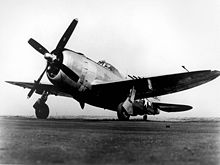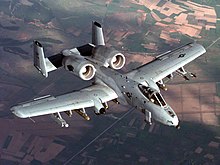Tactical air war
As a tactical bombing refers to the use of aircraft to combat enemy forces and military equipment in the battlefield. The three basic tasks are close air support , the attack of enemy ground targets in the immediate vicinity of one's own units, and the battlefield closure , which fights tactical targets in the rear area such as bridges and roads and the supplies behind the enemy war front .
General
Tactical air warfare, unlike strategic air warfare, is carried out from the front. Its planning does not require a long period of time. The composition of different squadrons must not be a condition of planning in tactical air warfare. Individual front line commanders up to the platoon leader can request air support. Groups of two or more aircraft are then dispatched to support and fight the specified area with bombs, missiles and on-board weapons. In tactical air warfare, the air force can almost replace artillery . These aircraft are usually already in the air at the time of the request by the respective commander. This part of the tactical air war, the close support of the fighting troops, is the classic one. Other tactical air support is the breaking up of enemy supply convoys, troop concentrations that the front-line commander does not know or cannot, and positions that stand in the way of an advancing troop.
history
First World War
The tactical air war began in the First World War . The first air raids were very primitive. Hand grenades and even light artillery rounds were thrown sideways by hand from biplanes. But there were also steel arrows, so-called flechettes, which had no explosive effect. But also pitches and other obstacles that were thrown in front of the enemy trenches were used. The impact of these attacks was very limited. There was a lack of bomb sights, the drop was based on a sense of proportion. With the end of the First World War, the first aircraft specially developed for ground combat were used. The Junkers company built the first all-metal monoplane, the Junkers J 10, since 1918 . At the side of this aircraft there were suspensions for four 9 kg bombs. The second man triggered this manually. These aircraft were used to fight artillery positions or enemy troop concentrations. On the Entente side , fighter planes were specially converted to perform the same task. When the Entente was in control of the air in the war from mid-1918 and the German army was in retreat, the fighter planes fell in packs over troop gatherings.
Second World War
During the Second World War , aircraft that had been fully developed for the task of battle or ground attack aircraft were used. The most famous representatives are the Junkers Ju 87 and the Russian Il-2 . Due to the lack of effective target devices for precise bombing in level flight, the Germans developed the Ju 87 even before the beginning of the war. It fought its target by diving towards it and releasing the bomb at the right moment. This enabled significantly more targeted attacks. In this way, even individually moving tanks could be fought precisely. In order to attack larger bunkers and fortresses, the Stuka , as the aircraft was commonly called, were even able to transport a 500 kilogram bomb. As the anti-tank defense became more and more important, the Ju 87 G was developed, an aircraft that carried two modified 37-mm cannons at lower wing stations. This machine was christened “Kanonenvogel” by the German soldiers. The most successful tank destroyer with this model was Hans-Ulrich Rudel . The Stuka became a symbol of the Blitzkrieg . Just as the armored troops were advancing miles deep into the enemy rear in rapid breakthrough battles, the Stuka was the "flying artillery". With the air superiority of the Allied fighters on all fronts, the Stuka lost more and more of its importance. New ways had to be found. The Focke-Wulf Fw 190 F aircraft were developed in a hurry . The Henschel Hs 129 was also designed as an attack aircraft . When the Messerschmitt Me 262 finally appeared, the aircraft was unceremoniously designated as a ground attack aircraft by a request by Adolf Hitler .
The Soviet leadership was looking for a different concept. With the Il-2, the Ilyushin design office developed an aircraft that was intended to attack and destroy its target primarily at low altitude. The Il-2 was armed with two heavy 20mm cannons and two 7.62mm machine guns. Lighter bombs than the Stuka and rockets up to caliber 132 mm could complete the armament. Il-2 were used en masse. No other ground attack or attack aircraft in all its variants was produced in large quantities. 36,136 of the Il-2s had been produced by the end of 1945. Another representative of a tactical bomber was the Petlyakov Pe-2 . It achieved similar performances as the British De Havilland DH.98 Mosquito . The Polikarpow Po-2 was a special form of the tactical bomber that the Red Army especially preferred . It was used as a reconnaissance aircraft and light bomber. However, at the beginning of the war, the aircraft was out of date. The Red Army used the aircraft as a nightly disruptor. At night, Po-2 planes took off and threw small bombs on the German positions. They were contemptuously called "taxiway crows" or "hooded crows" by the German soldiers. Their effect was limited, but they could, for example, disturb the German troops during the night, interrupt movements, disrupt breaks and thus undermine morale.
On the part of the western allies, at the beginning of the war there was a lack of concepts for a ground attack aircraft or tactical bomber. In order to perform tactical tasks, fighter planes were usually equipped with a bomb and sent into battle. This turned out to be problematic because the hunters were usually overwhelmed with carrying a heavy bomb. Exceptions are the De Havilland Mosquito as the first tactical bomber and the P-38 Lightning fighter . The latter was naturally heavily armed and as a twin-engine machine could also transport a relatively high payload. It was only around 1943, with the introduction of unguided rockets, that the load was no longer a problem for fighters and they often took on tasks as ground attack and attack aircraft. During the landing in Normandy in 1944, the Allies already had absolute air superiority . Movements of the German troops were only possible during the night, because swarms of fighters and fighter-bombers armed with rockets and bombs hunted down German convoys and positions. The most famous representatives of the Allies for these missions were the Republic P-47 Thunderbolt and the Hawker Typhoon .
Further development
The Korean War brought massive air forces back on the scene. The UN troops under the leadership of the USA relied on jet-powered ground attack aircraft from the beginning, although they still continued to use propeller guns for reasons of armament. The P-80 Shooting Star was such a representative, but the F-86 Saber could also be equipped with bombs and used as a tactical bomber. On the Korean side, the Ilyushin Il-10 was used and later the MiG-15 , which, like the Saber, had a different main task as a fighter aircraft, but could be equipped as a fighter-bomber. The nature of the task hadn't changed since World War II. The way in which the enemy was attacked had not changed either; that only happened during the Vietnam War. During the Vietnam War , targets for tactical bombing were often marked with smoke grenades by so-called forward air controllers from slow-flying propeller machines and then fought by high-flying bombers such as the Boeing B-52 . The first multi -role fighter planes like the F-4 Phantom were built. You could perform both the role of the fighter plane and that of the fighter-bomber depending on the design of the armament.
The first aircraft to be re-engineered as a pure ground attack aircraft was the A-10 Thunderbolt . Their GAU-8 Avenger 30mm Gatling cannon with uranium core ammunition, along with customized attack tactics, enable them to destroy any tank. A further 7 tons of ammunition in the form of bombs, guided missiles, cluster munitions and mines can be carried along.
Since the 1990s , tactical air warfare has increasingly been waged with precision-guided ammunition and cruise missiles due to better target accuracy . Strategic bombers can target so-called smart bombs , that is, guided “intelligent” weapons with an accuracy of a few meters. Multipurpose fighter aircraft can fulfill the tasks of a fighter, interceptor or a fighter-bomber. They have an arsenal with which they can fight not only enemy aircraft but also ships, tanks, buildings or troops more effectively than squadrons of fighters or bombers from the Second World War.
helicopter

The helicopter, invented as early as the Second World War, was for a long time only a means of transport for material, the wounded or was used as a link between the troops. The helicopter has been used as a combat helicopter since the Vietnam War . In this war, helicopters were used for combat. They received machine guns, missiles, and some were even able to drop bombs from suspensions. The helicopter developed into a tank destroyer. A single AH-64 Apache is today able to transport sixteen AGM-114 Hellfire missiles and fight as many targets at the same time. The orientation in helicopter construction follows the operational doctrine of the respective user. While the NATO countries always preferred fast attack helicopters, during the Cold War the Soviets developed heavy armored helicopters that were effective weapon platforms. Like the Mil Mi-24 (NATO code name Hind ), they could be equipped with a variety of weapons and even as combat helicopters fly a maximum of eight soldiers into a combat area and at the same time give them tactical air support. The helicopter is the main tactical support for frontline commanders today.
See also
literature
- Olaf Groehler : History of the Air War 1910 to 1980 . Military publishing house of the GDR, Berlin 1981, ISBN 3327002185 .
- Jim Winchester: Fighter jets . Parragon Books. Ltd., ISBN 1-40544-940-3 .
- Land war in the 20th century . Gondromverlag, Bindlach 2001.



